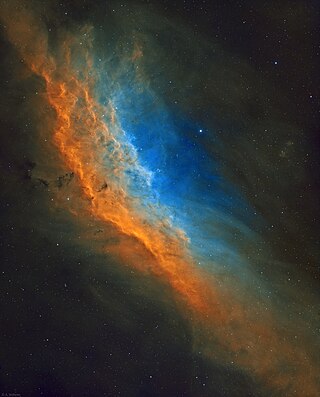Top Qs
Timeline
Chat
Perspective
California Nebula
Emission nebula in the constellation Perseus From Wikipedia, the free encyclopedia
Remove ads
The California Nebula (Also known NGC 1499 or Sh2-220) is an emission nebula located in the constellation Perseus. Its name comes from its resemblance to the outline of the U.S. State of California in long exposure photographs.
By coincidence, the California Nebula transits in the zenith in central California as the latitude matches the declination of the object.

Remove ads
Observation
NGC 1499 is almost 2.5° long on the sky and, because of its very low surface brightness, it is extremely difficult to observe visually. It can be observed with a Hα filter (isolates the Hα line at 656 nm) or Hβ filter (isolates the Hβ line at 486 nm) in a rich-field telescope under dark skies.[2] It lies at a distance of about 1,000 light years from Earth. Its fluorescence is due to excitation of the Hβ line in the nebula by the nearby prodigiously energetic O7 star, Xi Persei (also known as Menkib).[3]
Remove ads
Discovery
The California Nebula was discovered by E. E. Barnard in 1884.
References
External links
Wikiwand - on
Seamless Wikipedia browsing. On steroids.
Remove ads

